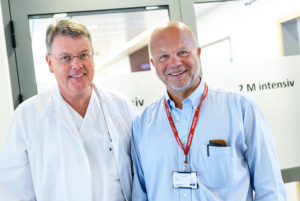 NEW INTERNATIONAL STUDY SHOWS LONGER COOLING AFTER HEART STAY DOES NOT GUARANTEE INTEREST OF PROGNOSEN
NEW INTERNATIONAL STUDY SHOWS LONGER COOLING AFTER HEART STAY DOES NOT GUARANTEE INTEREST OF PROGNOSEN
Stavanger University Hospital has, as the only Norwegian hospital, participated in a European cardiac arrest study recently published in the Journal of the American Medical Association (JAMA). Although the study did not show that the 48 hour cooling period yielded significantly better results than the standard 24 hour cooling, there was still an interesting difference in 6-month survival that could indicate that a major study should be conducted to clarify the question.
In 2013, Professor Eldar Søreide (K1) and Professor Alf Ingen Larsen (K2), as leaders of the Emergency Medical and Cardiological Research Group at SUS, entered into a research agreement with Aarhus University Hospital. One of the results is
Targeted Temperature Management for 48 vs 24 Hours and Neurologic Outcome After Out-of-Hospital Cardiac Arrest: A Randomized Clinical Trial.
Kirkegaard H, Søreide E, de Haas I, Pettilä V, Taccone FS, Arus U, Storm C, Hassager C, Nielsen JF, Sørensen CA, Ilkjær S, Jeppesen AN, Grejs AM, Duez CHV, Hjort J, Larsen AI, Toome V, Tiainen M, Hästbacka J, Laitio T, Skrifvars MB.
JAMA. 2017 Jul 25;318(4):341-350. doi: 10.1001/jama.2017.8978.
The study was duly commented on in a management article by one of the foremost experts in the field, Professor Cliffton Callaway of Pittsburgh University.
Callaway CW. JAMA. 2017 Jul 25;318(4):334-336. doi: 10.1001/jama.2017.8977.
Callway pointed out that although the study failed to show a statistically significant 15% absolute difference in survival between the Groups, the results indicated that there could be a minor but still interesting difference in favor of the longer cooling period. This will only confirm a much larger study. Futhermore, the study was famed for both good data quality and good follow up of the patients. Survival in both study Groups was also much higher than reported in previous similar studies. This may be due to serveral factors, not to mention that both prehospital and hospital treatment have gereally improved over the years.
The two Norwegian co-authors of the study wish to thank all involved healthcare professionals in general and the families and patients who said yes to participate in particular. They think this publication illustrates the possibilities and importance of collaboration between research groups and between institutions in several countries. That way, they hope the publication can serve as inspiration for younger colleagues.
